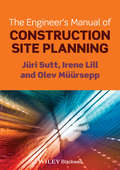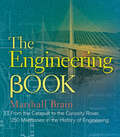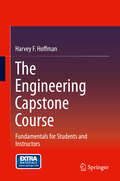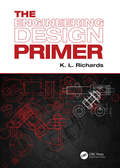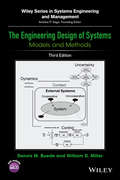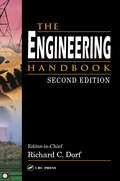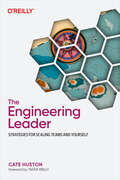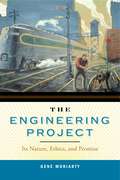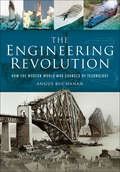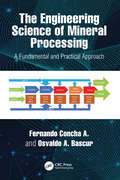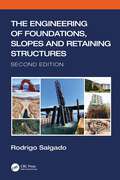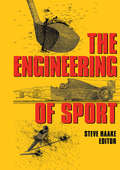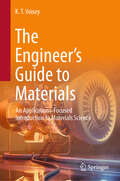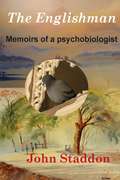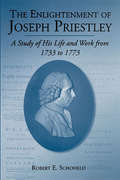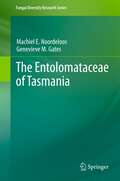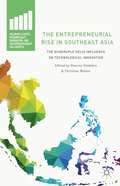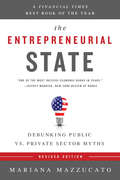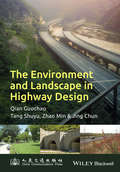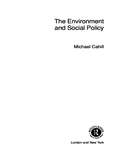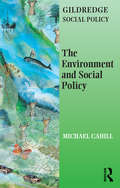- Table View
- List View
The Engineer's Manual of Construction Site Planning
by Olev Müürsepp Jüri Sutt Irene LillThis handbook addresses problems facing the engineer when preparing to build, both during the contract bidding phase and after a contract has been concluded. It offers clear guidelines for planning the resources and machinery on site, as well as the safe positioning of roads, cranes, storage and temporary buildings. Site planning activities are presented here in logical sequence, offering an efficient and safe design of the construction site and of the temporary works. The book describes the process of engineering preparation of on-site construction works in all phases of the construction life-cycle, from the design phase - preparing the financial plan and procurement scheme for the owner before tendering the contract; the tendering phase; and after bid completion. A list of procedures is presented for planning the construction site in order to simplify the engineer’s work of site and temporary works planning. The Engineer’s Manual of Construction Site Planning is for all those involved in the planning of construction sites, construction managers, construction engineers and quantity surveyors, as well as for students in civil engineering and construction.
The Engineering Book: From the Catapult to the Curiosity Rover, 250 Milestones in the History of Engineering (Union Square & Co. Milestones)
by Marshall BrainEngineering is where human knowledge meets real-world problems—and solves them. It's the source of some of our greatest inventions, from the catapult to the jet engine. Marshall Brain, creator of the How Stuff Works series and a professor at the Engineering Entrepreneurs Program at NCSU, provides a detailed look at 250 milestones in the discipline. He covers the various areas, including chemical, aerospace, and computer engineering, from ancient history to the present. The topics include architectural wonders like the Acropolis, the Great Wall of China, and the Eiffel Tower; transportation advances such as the high-speed bullet train; medical innovations, including the artificial heart and kidney dialysis; developments in communications, such as the cell phone; as well as air conditioning, DNA fingerprinting, the Large Hadron Collider, drones, and more.
The Engineering Capstone Course
by Harvey F. HoffmanThis essential book takes students and instructors through steps undertaken in a start-to-finish engineering project as conceived and presented in the engineering capstone course. The learning experience follows an industry model to prepare students to recognize a need for a product or service, create and work in a team; identify competition, patent overlap, and necessary resources, generate a project proposal that accounts for business issues, prepare a design, develop and fabricate the product or service, develop a test plan to evaluate the product or service, and prepare and deliver a final report and presentation. Throughout the book, students are asked to examine the business viability aspects of the project. The Engineering Capstone Course: Fundamentals for Students and Instructors emphasizes that a design must meet a set of realistic technical specifications and constraints including examination of attendant economics, environmental needs, sustainability, manufacturability, health and safety, governmental regulations, industry standards, and social and political constraints. The book is ideal for instructors teaching, or students working through, the capstone course.
The Engineering Design Primer
by K. L. RichardsCreated to support senior-level courses/modules in product design, K. L. Richard’s Engineering Design Primer reflects the author’s deep experience in engineering product management and design. The combination of specific engineering design processes within the broader context of creative, team-based product design makes this book the ideal resource for project-based coursework. Starting with design concepts and tasks, the text then explores materials selection, optimisation, reliability, statistics, testing and economic factors – all supported with real-life examples. Student readers will gain a practical perspective of the work they’ll be doing as their engineering careers begin. Features Presents the design, development and life-cycle management of engineered products Builds the skills and knowledge needed for students to succeed in their capstone design projects Brings design concepts alive with practical examples and descriptions Emphasises the team dynamics needed in engineering practice Examines probability, reliability, testing and life-cycle management of engineered products
The Engineering Design of Systems
by Dennis M. BuedeThe ideal introduction to the engineering design of systems--now in a new editionThe Engineering Design of Systems, Second Edition compiles a wealth of information from diverse sources to provide a unique, one-stop reference to current methods for systems engineering. It takes a model-based approach to key systems engineering design activities and introduces methods and models used in the real world. Features new to this edition include:The addition of Systems Modeling Language (SysML) to several of the chapters, as well as the introduction of new terminologyAdditional material on partitioning functions and componentsMore descriptive material on usage scenarios based on literature from use case developmentUpdated homework assignmentsThe software product CORE (from Vitech Corporation) is used to generate the traditional SE figures and the software product MagicDraw UML with SysML plugins (from No Magic, Inc.) is used for the SysML figuresThis book is designed to be an introductory reference and textbook for professionals and students in systems engineering. It is also useful in related courses in engineering programs that emphasize design methods and models.
The Engineering Design of Systems
by Dennis M. Buede William D. MillerNew for the third edition, chapters on: Complete Exercise of the SE Process, System Science and Analytics and The Value of Systems Engineering The book takes a model-based approach to key systems engineering design activities and introduces methods and models used in the real world. This book is divided into three major parts: (1) Introduction, Overview and Basic Knowledge, (2) Design and Integration Topics, (3) Supplemental Topics. The first part provides an introduction to the issues associated with the engineering of a system. The second part covers the critical material required to understand the major elements needed in the engineering design of any system: requirements, architectures (functional, physical, and allocated), interfaces, and qualification. The final part reviews methods for data, process, and behavior modeling, decision analysis, system science and analytics, and the value of systems engineering. Chapter 1 has been rewritten to integrate the new chapters and updates were made throughout the original chapters. Provides an overview of modeling, modeling methods associated with SysML, and IDEF0 Includes a new Chapter 12 that provides a comprehensive review of the topics discussed in Chapters 6 through 11 via a simple system - an automated soda machine Features a new Chapter 15 that reviews General System Theory, systems science, natural systems, cybernetics, systems thinking, quantitative characterization of systems, system dynamics, constraint theory, and Fermi problems and guesstimation Includes a new Chapter 16 on the value of systems engineering with five primary value propositions: systems as a goal-seeking system, systems engineering as a communications interface, systems engineering to avert showstoppers, systems engineering to find and fix errors, and systems engineering as risk mitigation The Engineering Design of Systems: Models and Methods, Third Edition is designed to be an introductory reference for professionals as well as a textbook for senior undergraduate and graduate students in systems engineering.
The Engineering Geology and Hydrology of Karst Terrains
by Barry F. BeckEngineers from around the world recount in this volume their successes and failures in attempting to deal with unique and quixotic landscapes.
The Engineering Handbook (ISSN)
by Richard C. DorfFirst published in 1995, The Engineering Handbook quickly became the definitive engineering reference. Although it remains a bestseller, the many advances realized in traditional engineering fields along with the emergence and rapid growth of fields such as biomedical engineering, computer engineering, and nanotechnology mean that the time has come to bring this standard-setting reference up to date.New in the Second Edition19 completely new chapters addressing important topics in bioinstrumentation, control systems, nanotechnology, image and signal processing, electronics, environmental systems, structural systems 131 chapters fully revised and updated Expanded lists of engineering associations and societiesThe Engineering Handbook, Second Edition is designed to enlighten experts in areas outside their own specialties, to refresh the knowledge of mature practitioners, and to educate engineering novices. Whether you work in industry, government, or academia, this is simply the best, most useful engineering reference you can have in your personal, office, or institutional library.
The Engineering Leader: Strategies for Scaling Teams and Yourself
by Cate HustonGreat engineers don't necessarily make great leaders—at least, not without a lot of work. Finding your path to becoming a strong leader is often fraught with challenges. It's not easy to figure out how to be strategic, successful, and considerate while also being firm. Whether you're on the management or individual contributor track, you need to develop strong leadership skills.This practical book shows you how to become a well-rounded and resilient engineering leader.Understand what it means to be the driving force behind your careerLearn how to self-manage and avoid the pitfalls that many newer managers faceEstablish evolving practices and structures to best scale your teamDefine the impact of your team and its core mission and values
The Engineering Project: Its Nature, Ethics, and Promise
by Gene MoriartyWe all live our daily lives surrounded by the products of technology that make what we do simpler, faster, and more efficient. These are benefits we often just take for granted. But at the same time, as these products disburden us of unwanted tasks that consumed much time and effort in earlier eras, many of them also leave us more disengaged from our natural and even human surroundings. It is the task of what Gene Moriarty calls focal engineering to create products that will achieve a balance between disburdenment and engagement: “How much disburdenment will be appropriate while still permitting an engagement that enriches one’s life, elevates the spirit, and calls forth a good life in a convivial society?”One of his examples of a focally engineered structure is the Golden Gate Bridge, which “draws people to it, enlivens and elevates the human spirit, and resonates with the world of its congenial setting. Humans, bridge, and world are in tune.” These values of engagement, enlivenment, and resonance are key to the normative approach Moriarty brings to the profession of engineering, which traditionally has focused mainly on technical measures of evaluation such as efficiency, productivity, objectivity, and precision. These measures, while important, look at the engineered product in a local and limited sense. But “from a broader perspective, what is locally benign may present serious moral problems,” undermining “social justice, environmental sustainability, and health and safety of affected parties.” It is this broader perspective that is championed by focal engineering, the subject of Part III of the book, which Moriarty contrasts with “modern” engineering in Part I and “pre-modern” engineering in Part II.
The Engineering Revolution: How the Modern World was Changed by Technology
by Angus BuchananOver the past two million years that human species have inhabited the Planet Earth they have distinguished themselves by their ability to make and do things creatively to ensure their survival. From the beginning, therefore, they have been defined by their technology, and the history of technology is the history of the species. For most of this period, the development of human technical skills has been extremely slow and repetitive, limited to basic tools and weapons and the ability to control fire. The utilization of animal power and the invention of the means of harnessing the power of wind and falling water added gradually to their technical skills, but it was the discovery of ways of using power from heat engines a mere three hundred years ago that accelerated this process into a prodigious expansion of technical power that fundamentally transformed human societies . It is this development which deserves to be to be called The Engineering Revolution and provides the primary focus of this book.
The Engineering Science of Mineral Processing: A Fundamental and Practical Approach
by Osvaldo A. Bascur Fernando Concha AThe Engineering Science of Mineral Processing: A Fundamental and Practical Approach emphasizes the fundamentals of mineral processing to provide readers with a deep understanding of the science and phenomena that occur during the processing of ores. It also offers guidance on contemporary process implementation through practical industry applications. It includes examples of dynamic simulations and practical execution of advanced software to guide operating plans to ensure optimal conditions that predict process constraints. Focuses on the science of mineral processing, including particulate systems, hydrodynamics, and physical chemistry Discusses modeling, rheology, comminution, classification, flotation, and solid-liquid separation Includes practical examples from real-world industrial applications Provides information on dynamic process simulations and the application of digital twins in mineral processing plants to improve management and efficiency Details the future of mineral processing in the digital era. Offering a balance between fundamentals and applications, this book will be of interest to researchers and industry professionals working to optimize mining, mineral and chemical processing plants. It will also be of value to advanced students taking mineral processing and chemical engineering courses.
The Engineering of Foundations, Slopes and Retaining Structures
by Rodrigo SalgadoThe Engineering of Foundations, Slopes and Retaining Structures rigorously covers the construction, analysis, and design of shallow and deep foundations, as well as retaining structures and slopes. It includes complete coverage of soil mechanics and site investigations. This new edition is a well-designed balance of theory and practice, emphasizing conceptual understanding and design applications. It contains illustrations, applications, and hands-on examples that continue across chapters. Soil mechanics is examined with full explanation of drained versus undrained loading, friction and dilatancy as sources of shear strength, phase transformation, development of peak effective stress ratios, and critical-state and residual shear strength. The design and execution of site investigations is evaluated with complete discussion of the CPT and SPT. Additional topics include the construction, settlement and bearing capacity of shallow foundations, as well as the installation, ultimate resistance and settlement of deep foundations. Both traditional knowledge and methods and approaches based on recent progress are available. Analysis and design of retaining structures and slopes, such as the use of slope stability software stability calculations, is included. The book is ideal for advanced undergraduate students, graduate students and practicing engineers and researchers.
The Engineering of Sport: Volume 3: Developments For Innovation
by Steve HaakeScience and technology has been used more and more in the last few decades to gain advantage over competitors. Quite often, however, the actual science involved is not published because a suitable journal cannot be found. The Engineering of Sport brings together work from a very diverse range of subjects including Engineering, Physics, Materials and Biomechanics.The Engineering of Sport represent work which was represented at the 1st International Conference on the Engineering of Sport held in Sheffield, UK in July 1996. Many sports were represented and the material covered split into nine topics covering aerodynamics, biomechanics, design, dynamics, instrumentation, materials, mechanics, modelling, motion analysis, and vibrations. It should be of interest to specialists in all areas of sports research.
The Engineer’s Guide to Materials: An Applications-Focused Introduction to Materials Science
by K. T. VoiseyWhy do engineers need to know about materials? Metals, polymers, ceramics, composites — what are the key characteristics of each class of material and which is best suited for a given industrial application? How can service conditions change the performance of materials? This compact undergraduate textbook gives you, the engineer, insight into these questions and the information you need to effectively interact with materials experts from all walks of life and gain a foothold in your budding career as a materials-literate engineer.Featuring familiar examples from the aviation and the automotive industries, this applications-led approach focuses on illustrating key concepts, giving real-world context to the material presented. In addition, the book acquaints you with important operational aspects of materials selection, such as costs, environmental impact, and sustainability. Optimised for mechanical and aerospace engineers, this book is also suitable for students in the adjacent fields of civil, industrial, and manufacturing engineering. Concise, practical, and easy to understand — this textbook is the ideal accompaniment to any introductory engineering course.
The Englishman: Memoirs of a Psychobiologist
by John Staddon"Although I have been basically an academic for most of my life, the way I got there has taken some surprising turns. The first four chapters of this memoir describe what I can remember and discover about my early life: an unsuspected ancestry, fun in WW2 London, comical schooldays, and a spell in colonial Africa interrupting a wobbly college career at the end of which I left England for America. In the US I followed again a slightly erratic graduate-school trajectory that ended up in a Harvard basement."This is not just a witty transatlantic autobiography from a talented English working-class kid who made his name in the USA but also a learned and entertaining romp through the subject he has made his own. Growing up in a modest odd family out in wartime England, and with a natural resistance to regimentation, John Staddon was the precocious self-driven polymath who first studied chemical engineering but switched to psychology because there were only four or five classes a week. By way of his wide-ranging interests in biology, artificial intelligence, economics, philosophy and behavioural neuroscience, John Staddon introduces his important work on how animals learn. He discusses the still relatively new and exciting field of behavioural psychobiology, explains theoretical research on choice and interval timing and debates so-called superstition in the learned behaviour of pigeons, rats, fish - and people. Here is a most entertaining life story interwoven with expansive thoughts across the marvellously wide spectrum of behavioural psychology.
The Enlightened Joseph Priestley: A Study of His Life and Work from 1733 to 1773
by Robert SchofieldJoseph Priestley (1733–1804) is one of the major figures of the English Enlightenment. A contemporary and friend of Benjamin Franklin and Thomas Jefferson, he exceeded even these polymaths in the breadth of his curiosity and learning. Yet no one has attempted an all-inclusive biography of Priestley, probably because he was simply too many persons for anyone easily to comprehend in a single study. Robert Schofield has devoted a lifetime of scholarship to this task. The result is a magisterial book, covering the life and works of Priestley during the critical first forty years of his life. <P><P>Although Priestley is best known as a chemist, this book is considerably more than a study in the history of science. As any good biographer must, Schofield has thoroughly studied the many activities in which Priestley was engaged. Among them are theology, electricity, chemistry, politics, English grammar, rhetoric, and educational philosophy. Schofield situates Priestley, the provincial dissenter, within the social, political, and intellectual contexts of his day and examines all the works Priestley wrote and published during this period. <P><P>Schofield singles out the first forty years of Priestley's life because these were the years of preparation and trial during which Priestley qualified for the achievements that were to make him famous. The discovery of oxygen, the defenses of Unitarianism, and the political liberalism that characterize the mature Priestley—all are foreshadowed in the young Priestley. A brief epilogue looks ahead to the next thirty years when Priestley was forced out of England and settled in Pennsylvania, the subject of Schofield's next book. But this volume stands alone as the definitive study of the making of Joseph Priestley.
The Entolomataceae of Tasmania
by Genevieve M. Gates Machiel NoordeloosThis book is the result of 14 years of collecting Entolomataceae in the native forests of Tasmania, Australia. Although initially involving only the Tasmanian residents Genevieve Gates and David Ratkowsky, who made twice- or thrice-weekly forays into the forests throughout the year, the project was subsequently joined by agaric specialist Machiel Noordeloos from the Netherlands, and by fungi photographer Michael Pilkington from the United Kingdom. The international character of the project is further evidenced by the earlier contributions of American mycologist Tim Baroni to the Tasmanian Rhodocybe species which form the basis of the chapter on the now-expanded concept of Clitopilus, and a visit of several months in 2010 by Brazilian Ph.D. candidate Fernanda Karstedt, who tested the keys to the Entoloma species. Consequently, several thousand well-annotated collections were found during this inventory and form the basis of this monographic treatment of the Entoloma and Clitopilus of Tasmania. The resulting 90 Entoloma species and 10 Clitopilus species are well documented with standardized descriptions, line drawings of fruit bodies and diagnostic microscopic characters, and, when available, with colour photographs. Thanks to the intensive search, it was possible to illustrate most species in colour. Dichotomous keys facilitate identification of the species. The species concept used is morphologically based; in several cases, however, identification to species level is supported by molecular data.
The Entrepreneurial Engineer
by Michael B. Timmons Rhett L. Weiss Daniel P. Loucks John R. Callister James E. Timmons Michael B. Timmons Rhett L. Weiss Daniel P. Loucks John R. CallisterThe authors, educators and successful entrepreneurs, wrote this textbook with the goal of maximizing your chance of entrepreneurial success. It is designed to encourage those who want to start a business and those who have already begun. It includes guidance, instruction, and practical lessons for the prospective entrepreneur. The book focuses on early stage financing of a startup company, beginning with an emphasis on constructing an effective business plan, including writing techniques to help convey your message, and preparing solid financial statements. This "why" and "how" of writing a business plan is followed by recommendations on raising outside capital. Important topics include developing your marketing strategy, recruiting and managing creatives and managers, and retaining effective employees. Legal structures, negotiation strategies, and economic evaluation of opportunities are also discussed. The book concludes with a chapter on project management. The book includes many engineering economy topics, sufficient for those who will be taking the FE Exam.
The Entrepreneurial Project Manager (Best Practices in Portfolio, Program, and Project Management)
by Chris CookDoing more with less is a skill mastered by entrepreneurs. Budgets are tight, deadlines are short, and time is of the essence. Entrepreneurial project managers use these parameters to their benefit. Hurdling over obstacles with the bare minimum of effort makes their projects and teams stand out. Focusing inward to develop the skills and mindset necessary to accomplish anything with anyone sets an entrepreneurial project manager apart from the group. This book builds on the basics of project management knowledge with tools and techniques to get you as well as your projects and teams performing on an advanced level. No matter your industry or experience level, this book gives you practical ways to improve any project. More importantly, it shows how you can improve your own performance. The biggest improvements a project manager can make are about him- or herself. Personal limitations can be the hardest obstacle to overcome, and this book explains how to overcome them. The techniques have been tried and tested by the author who shares them with you in this book. Whether in your projects or career, all the right things can be said and done, yet the results are always unpredictable. We all have little control over events. This book’s tools and techniques give you the ability to handle anything that may come your way. Entrepreneurs are constantly changing and adapting to the world around them. They must stay cutting-edge to make their businesses thrive. This book explains how to take a cutting-edge approach to project management. The goal is to take your technical skills as a project manager, add the elements of an entrepreneur, and create a high-powered team around you as well as become the best project manager you can be.
The Entrepreneurial Rise in Southeast Asia
by Stavros Sindakis Christian WalterThe Entrepreneurial Rise in Southeast Asia examines the start-up scene environments in Singapore, Malaysia, Vietnam, Thailand, and Indonesia. The contributors to this volume explore government strategies to support start-up communities, local challenges, and unique strengths of each country. They answer key questions framing policy and strategic decision-making at the firm, industry, national, and regional levels, such as: How does technological advance occur, and what are the process and institutions involved? Which cultural characteristics serve to promote or impede innovation? And, in what ways is wealth distributed or concentrated?
The Entrepreneurial State: Debunking Public vs. Private Sector Myths (Anthem Other Canon Economics Ser. #1)
by Mariana MazzucatoCompanies like Google and Apple heralded the information revolution, and opened the doors for Silicon Valley to grow into an engine of dazzling technological development, that today champions the free market that engendered it against the supposedly stifling encroachment of government regulation. But is that really the case? In this sharp and controversial expose, The Entrepreneurial State, Mariana Mazzucato debunks the pervasive myth that the state is a laggard, bureaucratic apparatus at odds with a dynamic private sector. Instead she reveals in case study after case study that, in fact, the opposite is true: the state is our boldest and most valuable innovator. The technology revolution would never have happened without support from the US Government. The breakthroughs--GPS, touch-screen displays, the Internet, and voice-activated AI--that enabled legendary Apple products to be smart successes were, in fact, all developed with support from the state. Mazzucato reveals that many successful entrepreneurs like Steve Jobs integrated state-funded technological developments into their products and then reaped the rewards themselves. The algorithm behind Google’s search engine was initially sponsored by NASA. And 75% of NMEs--new, often-ground-breaking drugs not derivative of existing substances--trace their research to National Institutes of Health (NIH) labs. The American government, it turns out, has been enormously successfully at stimulating scientific and technological advancement. But by 2009, just some months following the Great Recession--the US government, constrained by austerity measures, started disinvesting from its holdings in research fields like health, energy, electronics. The trend is likely to continue, and the repercussions of these policies could wreak havoc on our technology and science sectors. But Mazzucato remains optimistic. If managed correctly, state-sponsored development of Green technology, for instance, could be as efficacious as suburbanization & post-war reconstruction in the mid-twentieth century, and unleash a wide-spread golden age in the global economy. The limitations of natural resources and the threat of global warming could become the most powerful driver of growth, employment, and innovation within just one generation--but to be successful, the Green Revolution will depend on the initiatives of proactive governments. By not admitting the State’s role in economic and technological progress, we are socializing only the risks of investing in innovation, while privatizing the rewards in the hands of only a few businesses. This, Mazzucato argues, hurts both future of innovation and equity in modern-day capitalism. For policy-makers, Silicon Valley start-up founders, venture-capitalists, and economists alike, The Entrepreneurial State stirs up much needed debate and offers up a brilliant corrective to spurious beliefs: to thrive, American businesses have always and will need to depend on the support of our country’s most audacious entrepreneur, the state.
The Environment and Landscape in Motorway Design
by Chun Jing Guochao Qian Shuyu Tang Min ZhangThe construction and operation of highways has a significant impact on the environment. While such impact is impossible to avoid, modern highways are constructed and landscaped to minimise these impacts as far as possible. Good landscaping minimises the impact on those living or working close to the highway, while at the same time regenerating the natural landscape disturbed during construction. Using as its background the successful landscape design of the Nanjing-Hangzhou Expressway in Jiangsu Province, China, which opened to traffic in 2007, Highway Landscape Design includes reference to all aspects of the landscaping of highways, including interchanges, embankments, central reservations, bridges, service and toll station areas, and drainage systems. Appropriate consideration is given to the negative impact on the surrounding environment during the process of construction and it discusses the ecological evaluation and conservation strategy for the highway route. China is in some respects at the forefront of highway landscape design as a result of rapid growth and development coupled with the financial resources to implement major infrastructure works, and the concepts, technologies and methods developed for this Expressway provide valuable experience for sustainable development strategies for such infrastructure.
The Environment and Social Policy (The Gildredge Social Policy Series)
by Michael CahillFocusing on human welfare and the environment from a social policy perspective, this text shows how environmental concerns are becoming increasingly central to policy-making and discusses the roles of central and local government in relation to environmental issues.The Environment and Social Policy covers the following contemporary topics: sustainability, Local Agenda 21, green ideas, environmental health, housing and urban development, food, work and globalisation. Each chapter starts with an overview of the topic and ends with a list of key points and a guide to further reading. Core concepts are clearly explained and illustrated throughout this text which provides students with a concise and up-to-date summary of what they need to know.
The Environment and Social Policy (The Gildredge Social Policy Series)
by Michael CahillFocusing on human welfare and the environment from a social policy perspective, this text shows how environmental concerns are becoming increasingly central to policy-making and discusses the roles of central and local government in relation to environmental issues.The Environment and Social Policy covers the following contemporary topics: sustainability, Local Agenda 21, green ideas, environmental health, housing and urban development, food, work, globalisation. Each chapter starts with an overview of the topics and ends with a list of key points and a guide to further reading. Core concepts are clearly explained and illustrated throughout this text which provides students with a concise and up-to-date summary of what they need to know.
